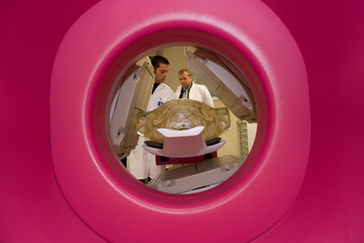Pharmacokinetic imaging
Quantitative information on the mobility of molecules and nanoparticles is crucial for a range of research areas, including drug delivery studies. Several complementary advanced fluorescence microscopy techniques have been developed to study the dynamic properties of drug delivery systems.
These techniques can be applied in complex biological media such as blood and serum, the extracellular matrix (biofilms, vitreous, mucus), or inside living cells.

Fluorescence Correlation Spectroscopy (FCS)
FCS is based on detection of fluorescent molecules entering and leaving the focal volume of a confocal microscope. This results in a time trace of fluorescence fluctuations. By applying an autocorrelation analysis on this time trace, the diffusion coefficient D and the average concentration in the detection volume can be determined. By labelling two species, their association and dissociation can be analysed.
Monitoring the amount of free molecules and complexed molecules enables the analysis of complex stability in buffer and biological fluids such as human serum.
Particles and molecules ranging from 1 to 100 nm, labelled with a photostable dye can be measured by FCS. The measurements are performed at low concentration (5-20 nM).
Fluorescence Recovery After Photobleaching (FRAP)

FRAP measures the diffusion of fluorescently labeled molecules or particles, based on the mass transfer after creating a concentration gradient. The experiment takes place on a micrometer scale in a non-invasive and specific way, allowing for measurements in complicated biomaterials. FRAP can be applied to particles ranging from 1 nm to 1 µm in diameter, present at a high concentration (mg/ml), and labelled with a photobleachable dye.
During a FRAP experiment, an area is photobleached after measuring the fluorescence of the sample. This creates a local concentration gradient of fluorescent molecules.
The net diffusion of photobleached molecules out and fluorescent molecules into the photobleached area is monitored and fitted with a FRAP model to extract the diffusion coefficient D and the (im)mobile fraction k.

Single particle tracking (SPT)
SPT visualises the movement of individual molecules or nanoparticles. After reconstructing their trajectories, the distribution of the diffusion coefficient D, the associated particle size and concentration can be analysed. As a population of single particles is analysed, subpopulations can be studied. In addition, trajectories hold information on the mode of motion.
Our work
The experts
The Ghent Light Microscopy (GLiM) core facility provides access to a broad range of state-of-the-art light microscopes that are frequently used in life science research. In combination with extensive expertise in a broad variety of microscopy techniques we provide full support from experimental design and training, to data acquisition and data analysis.











